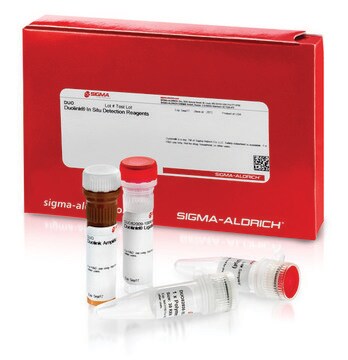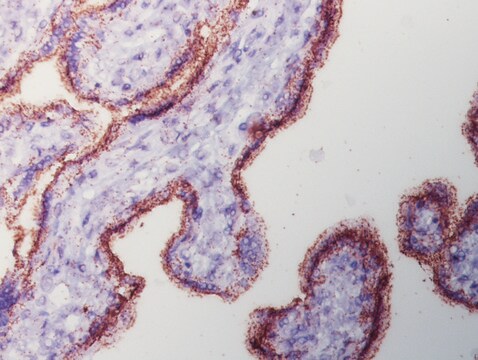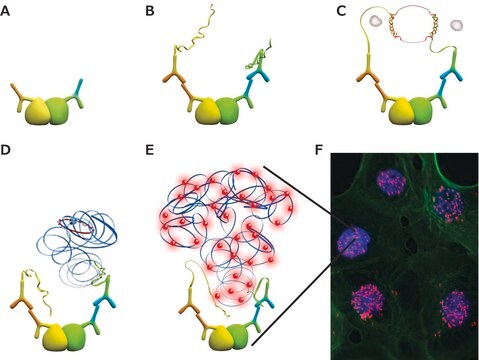DUO92014
Duolink® In Situ Detection Reagents Green
Sinônimo(s):
in situ Proximity Ligation Assay reagent, Protein Protein Interaction Assay reagent
About This Item
Produtos recomendados
linha de produto
Duolink®
Nível de qualidade
técnica(s)
proximity ligation assay: suitable
fluorescência
λex 495 nm; λem 527 nm (green) (FITC (Cyanine 2), Zeiss Filter set 38)
adequação
suitable for fluorescence
Condições de expedição
dry ice
temperatura de armazenamento
−20°C
Categorias relacionadas
Descrição geral
Especificidade
Aplicação
- vasopressin and gonadotropin-releasing hormone (GnRH) from frozen rat brain sections
- human embryonic kidney 293 cells (HEK)
- pituitary tissues
Características e benefícios
- No overexpression or genetic manipulation reNo overexpression or genetic manipulation required
- High specificity (fewer false positives)
- Single molecule sensitivity due to rolling circle amplification
- Relative quantification possible
- No special equipment needed
- Quicker and simpler than FRET
- Increased accuracy compared to co-IP
- Publication-ready results
Componentes
- 5x Ligation - Contains oligonucleotides that hybridize to the PLA probes and all components needed for ligation except the Ligase
- 1x Ligase (1 unit/μL)
- 1x Polymerase (10 units/μL)
- 5x Amplification Green - Contains all components needed for Rolling Circle Amplification (RCA) except the Polymerase. It also contains oligonucleotide probes labeled with a fluorophore that hybridize to the RCA product.
Not included in Detection kit:
Primary antibodies, PLA probes, wash buffers, mounting medium
Nota de preparo
Armazenamento e estabilidade
Outras notas
Visit our Duolink® PLA Resource Center for information on how to run a Duolink® experiment, applications, troubleshooting, and more.
Let us do the work for you, learn more about our Custom Service Program to accelerate your Duolink® projects
View full Duolink® product list
Informações legais
Código de classe de armazenamento
10 - Combustible liquids
Classe de risco de água (WGK)
WGK 2
Certificados de análise (COA)
Busque Certificados de análise (COA) digitando o Número do Lote do produto. Os números de lote e remessa podem ser encontrados no rótulo de um produto após a palavra “Lot” ou “Batch”.
Já possui este produto?
Encontre a documentação dos produtos que você adquiriu recentemente na biblioteca de documentos.
Os clientes também visualizaram
Artigos
Find Duolink references based on the type of method used, post translational modification detected, and research focus.
Conteúdo relacionado
Applications to detect, quantify and visualize protein-protein interactions, post-translational modifications and low expression protein detection using proximity ligation assay
Nossa equipe de cientistas tem experiência em todas as áreas de pesquisa, incluindo Life Sciences, ciência de materiais, síntese química, cromatografia, química analítica e muitas outras.
Entre em contato com a assistência técnica









